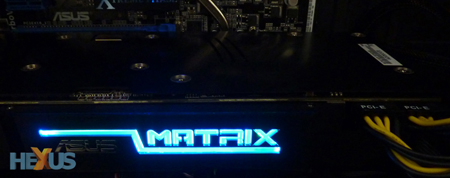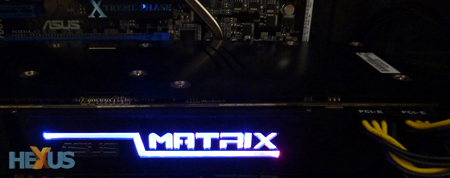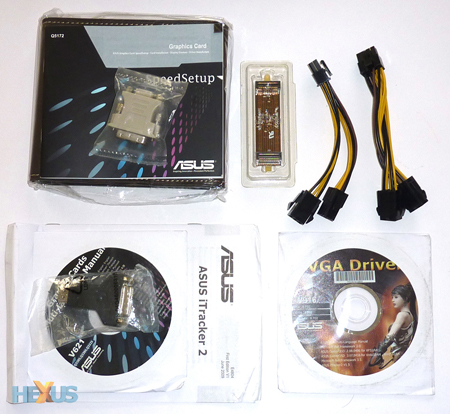The beast
ASUS' latest incarnation of the MATRIX line is the Platinum Edition 2,048MB. The card's core is overclocked out of the box, from a default core speed of 850MHz to 900MHz but the memory speed is kept at the default level of 4,800MHz. Going by what we have seen before from the likes of Sapphire, XFX, MSI and PowerColor, the overclock is about average.The design looks good and construction feels solid. Both the cooler and PCB are in-house-designed by ASUS, which maintains that, using the wonderfully-titled Super Hybrid Engine, the fan provides 22 per cent greater air pressure and 13 per cent lower temperatures than the reference card.
The Batman-esque vents are gone and replaced by smaller slits that help with airflow over the hot-running components.
Rather gimmicky in nature and viewable if your chassis has a side panel, ASUS includes LED lights behind the card's name. The LEDs shine one of five colours depending upon load on the GPU.
Here we see cyan for light loading (idling in Windows) and pink for heavy load (gaming). The LED section protrudes from the side of the card but is not tall enough to cause any problems with fitment in most chassis.
Eagle-eyed readers will notice that, like MSI's Lightning, the card ships with two side-mounted eight-pin power connectors. The reference Radeon HD 5870 only requires two six-pins, so it's a case of having additional power on tap.
An all-in-one heatsink hides the extra chips that make up the double-sized frame-buffer, amounting to 2,048MB in this case. ASUS also includes Probelt points that enable you to directly measure voltages for the GPU, memory, and PCIe bus via a multimeter.
The back becomes very warm during operation, hinting at efficient heat removal, but the air has nowhere to go except into the chassis.
A non-standard I/O section means that ASUS drops one of the usual DVI ports. Fear not, however, as the package also includes an HDMI-to-DVI adapter, just in case you need to use it.
Keeping the non-standard theme going, there's a 'safe mode' switch that reverts the clockspeeds back to default if you've pushed it too far. Think of it as a clear-CMOS button on a motherboard.
A fairly standard bundle that ships without a triple-A game, ASUS does throw in a couple of useful utilities to appease the enthusiast.
iTracker2 is the company's overclocking software that matches most of what the competition offers. GPU voltage can be tuned from 900mV to 1,600mV (1,200mV is default). Memory voltage runs through 1,300mV to 1,800mV (1,650mV default), and you can save any changes in one of four profiles. The one advantage that it has lies with the ability to manually reprogram the GDDR5 memory's timings, which is geekily cool.
Summary
The ASUS Radeon HD 5870 MATRIX Platinum is an in-house-designed, pre-overclocked card with a 2,048MB frame-buffer. Ostensibly designed to appeal to those who use ultra-high resolutions through a multi-monitor setup powered by Eyefinity, the extra goodies over a stock card will translate to an etailer price of around £400, or, more pertinently, very much in GeForce GTX 480 territory.

















